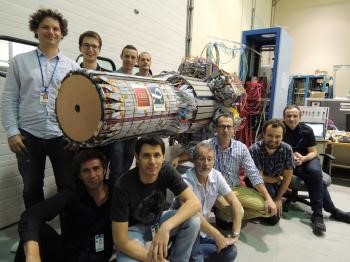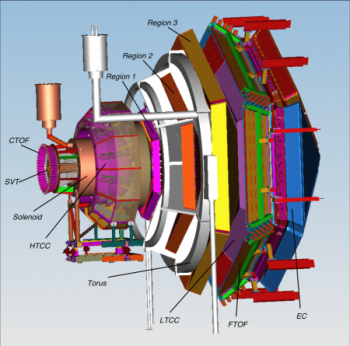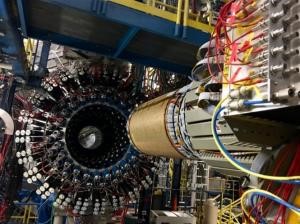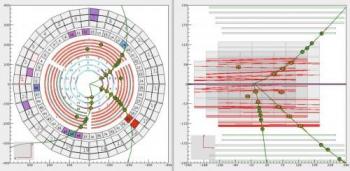As part of the new CLAS spectrometer project for the 12 GeV electron energy upgrade of the Jefferson Lab (USA) IRFU has been conducting R&D for more than 10 years to design and build a new generation tracker, using thin and flexible MICROMEGAS detectors that are now operating with the new CLAS12 spectrometer. After one year of installation, this tracker is operational and meets the expected characteristics with more than 95% detection efficiency and a spatial resolution of less than 100μm. After a dedicated data collection to measure the detector response, the new CLAS12 spectrometer is now collecting data for the DVCS physics experiment, where IRFU also participates and which objective is to measure the internal structure of the proton in three dimensions.
The exceptional success of the tracker project, that results from a close collaboration between IRFU's engineering and physics departments (DEDIP, DIS and DPHN), has been an example for other projects. Let us quote the LHC experiments for particle hunting, the muonic imaging of the pyramids, as well as a transfer of know-how to industry.
From CLAS to CLAS12
In Hall B, the high acceptance spectrometer CLAS is completely redesigned to become CLAS12 with two sub-assemblies: a central detector and a forward detector.
• The central detector, surrounding the target and placed inside a 5-tesla solenoidal magnetic field, detects particles at wide angles (35° to 125°) and of low energy. The central detector, surrounding the target, is constituted by a central tracker, a flight time counter and a neutron counter.
• The forward detector allows the detection of particles between 5 and 35°, and is composed of drift chambers in a toroidal field, Cherenkov counters, a flight time counter and finally an electromagnetic calorimeter.
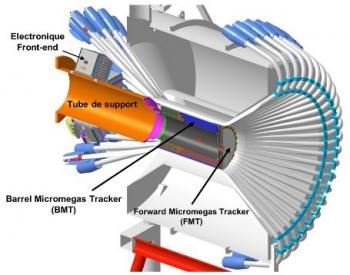
Vertical section of the CLAS12 central detector and in particular of the MICROMEGAS tracker for CLAS12.
The IRFU contribution to the CLAS12 spectrometer is focused on the central tracker, included in the central detector. The first part consists of a cylindrical assembly of three double layers of MICROMEGAS that complement Silicon detectors developed by Jefferson Lab and located just around the target: it is the MICROMEGAS Vertex Tracker or MVT. A second part, at the border between the central detectors and downstream, consists of three double layers of circular MICROMEGAS detectors perpendicular to the direction of the beam for the reconstruction of traces of particles emitted between 5 and 35°: it is the Forward MICROMEGAS Tracker or FMT.
10 years of R&D
The MVT, due to the use of flexible detectors allowing its cylindrical geometry, is the result of more than 10 years of R&D at IRFU, conducted thanks to the MPGD (Micro-Pattern Gas Detector) workshop at DEDIP where the first curved MICROMEGAS detectors were manufactured. The transparency to particles of curved and thin MICROMEGAS is a constraint of this project, their radiation length is about 0.4%.
The MVT and FMT together form a 4m² detection surface with 24,000 tracks, read by an electronic system, also developed for IRFU, ASIC DREAM and its front card, which allow recording of high flux of data without dead time. Finally, the internal mechanical support assembly had to be as transparent as possible to particles and was designed mainly in carbon fibers mounted on a support tube where the six boxes including the 48 front cards of the reading electronics are installed. The constraint of distance between the detectors and the reading electronics has led to R&D for the use of low-capacity cables. The detectors are read through coaxial microphone cables, from 1.5 m to 2.2 m long, with a linear capacity of 40 pF/m.
The use of gaseous electron-drift detectors in a 5 tesla magnetic field was validated by simulations and a series of magnet tests, which limited the degradation of spatial resolution due to the Lorentz angle by increasing the drift potential.
To be able to characterize the thirty CLAS12 detectors with minimum ionization particles (MIP), a cosmic test bench has been developed with a multiplexing system allowing to use a minimum of electronic channels for a resolution of about 100 µm. Improvements to this cosmic test bench have paved the way for experiments dedicated to muonic tomography.
Scientific and technical benefits
The developed technologies are protected by a licence and have been applied in fundamental research, both in IRFU projects such as the experiments COMPASS, MINOS, NSW, NTOF, NBNL, GBAR, MIMOSA, and also for the needs of other institutes, within the ASACUSA, Forward Tagger, Bonus TPC experiments. The R&D on MICROMEGAS is also the subject of industrial developments, in particular with the printed circuit board manufacturer ELVIA.
The "first steps" of the tracker
The installation was carried out in two phases, with the first two detection layers in December 2016, then the rest of the MVT and FMT set in June 2017 with all detection layers, the 24,000 electronic channels and the related air cooling, the final mechanics and a gas distribution system controlled by an PLC. The integration with the rest of the central detector and the insertion into the magnet was successfully completed at Jefferson Lab in the process, in millimeter interface areas. Detector noise levels remained as low as expected and beam data collection began in December 2017 until February 2018 for commissioning. By the end of 2017, our teams were able to observe the first beam traces in the MICROMEGAS detectors. Data collection for the Deeply Virtual Compton Diffusion Experiment (DVCS) then began in two phases in March 2018 and again at the end of August 2018. Between the two, maintenance was carried out at Jefferson Lab by IRFU teams to ensure that the restart would be carried out under the best possible conditions.
The tracker is operational and acquires data for the DVCS physics experiment which objective is to measure generalized parton distributions allowing a three-dimensional approach to the nucleon structure. The performance of this new CLAS12 spectrometer will significantly improve the measurement of these observables. The DPHN physicists are involved in the analysis of the data, the results of which will be published in next future.
Contacts: Franck Sabatié, Stéphan Aune
• Innovation for detection systems › Detectors for both infinite physics Structure of nuclear matter › Quarks and gluons hadron structure › MPGD Activities
• The Electronics, Detectors and Computing Division • The Nuclear Physics Division • The Systems Engineering Division
• Laboratory of Mechanical Studies and Detectors Integration (LEMID) • Nucleon Structure Laboratory (LSN) - The internal structure of hadrons
• CLAS12 • CLAS12-Tracker



